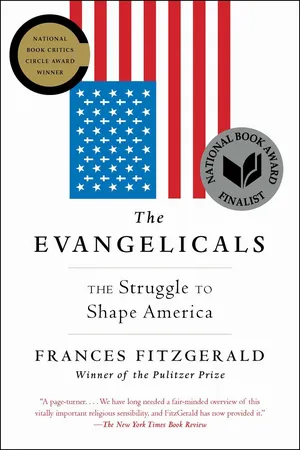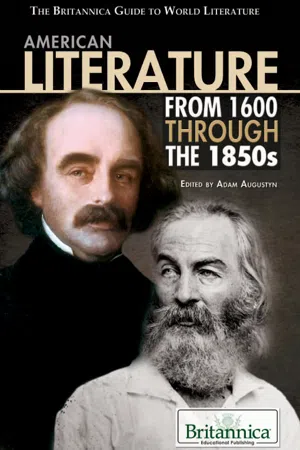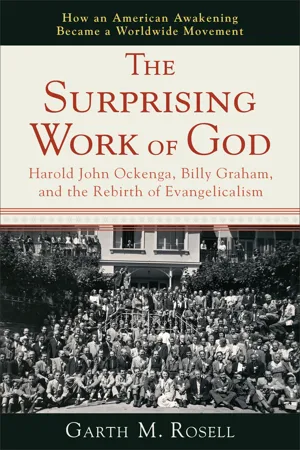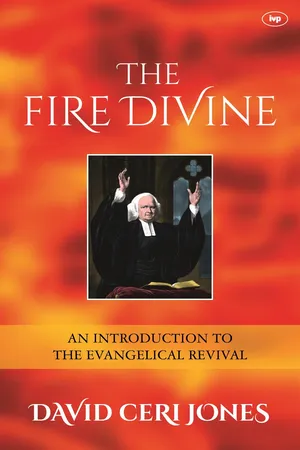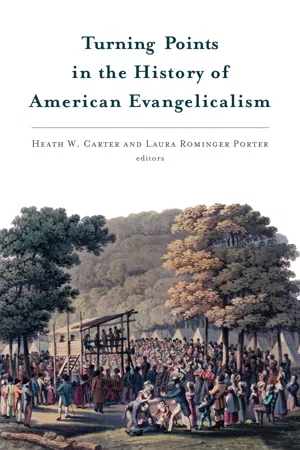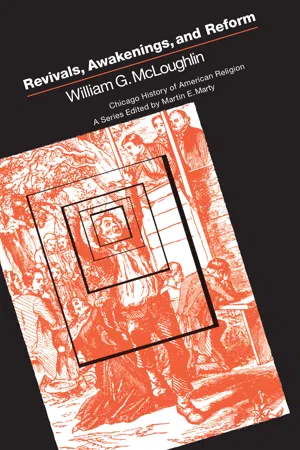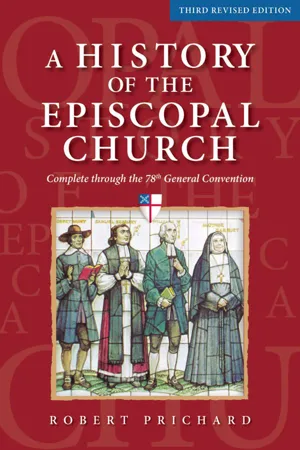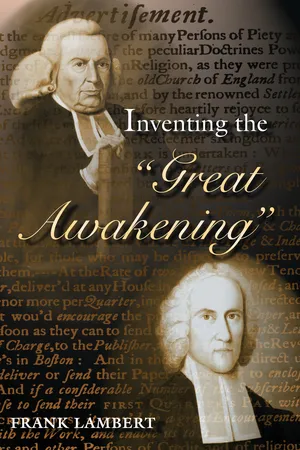History
The Great Awakening
The Great Awakening was a religious revival movement that swept through the American colonies in the 1730s and 1740s. It emphasized a personal connection with God and challenged traditional religious authority, leading to the rise of new denominations and a greater emphasis on individual spiritual experience. The movement had a significant impact on American society, politics, and culture.
Written by Perlego with AI-assistance
Related key terms
Related key terms
1 of 4
Related key terms
1 of 3
12 Key excerpts on "The Great Awakening"
- eBook - ePub
- Perry Miller(Author)
- 1956(Publication Date)
- Belknap Press(Publisher)
Once this international viewpoint is assumed, the American outburst becomes merely one among many — a colonial one at that — and we hesitate to speak about it as a crisis in a history specifically American. What was at work throughout the Western world is fairly obvious: the upper or the educated classes were tired of the religious squabbling of the seventeenth century, and turned to the more pleasing and not at all contentious generalities of eighteenth-century rationalism; the spiritual hungers of the lower classes or of what, for shorthand purposes, we may call “ordinary” folk were not satisfied by Newtonian demonstrations that design in the universe proved the existence of God. Their aspirations finally found vent in the revivals, and in each country we may date the end of a Calvinist or scholastic or, in short, a theological era by the appearance of these movements, and thereupon mark what is by now called the era of Pietism or Evangelicalism.In this frame of reference, The Great Awakening was only incidentally American. It is merely necessary to translate the European language into the local terminology to have an adequate account. In this phraseology, The Great Awakening in New England was an uprising of the common people who declared that what Harvard and Yale graduates were teaching was too academic. This sort of rebellion has subsequently proved so continuous that one can hardly speak of it as a crisis. It is rather a chronic state of affairs. And in this view of it, the uprising of 1740 belongs to the international history of the eighteenth century rather than to any account of forces at work only on this continent.Told in this way, the story will be perfectly true. Because we talk so much today of the unity of Western European culture, maybe we ought to tell it in these terms, and then stop. But on the other hand there is a curiously double aspect to the business. If we forget about Germany and Holland and even England — if we examine in detail the local history of Virginia, Pennsylvania, and New England — we will find that a coherent narrative can be constructed out of the cultural developments in each particular area. This Awakening can be seen as the culmination of factors long at work in each society, and as constituting, in that sense, a veritable crisis in the indigenous civilization. - eBook - ePub
The Evangelicals
The Struggle to Shape America
- Frances FitzGerald(Author)
- 2017(Publication Date)
- Simon & Schuster(Publisher)
1
The Great AwakeningS and the EVANGELICAL EMPIRE
T HE ORIGINS of evangelicalism as a distinct form of Protestantism lie in the revivals that swept back and forth across the English-speaking world and Northern Europe in the eighteenth and nineteenth centuries. In the American case, the revivals came in two waves. The earlier, known as the First Great Awakening, peaked in the 1740s but set off reverberations that continued to the time of the American Revolution. The later one, the Second Great Awakening, began just after the end of the War of Independence and continued intermittently in various parts of the country through the 1850s. Everywhere, the revivals involved a rebellion against the formalism of the established churches and an effort to recover an authentic spiritual experience: a religion of the heart, as opposed to the head. And everywhere, they introduced a new idea of conversion as a sudden, overwhelming experience of God’s grace. In Europe the established churches survived and incorporated the pietistic strain within their own traditions. But in America the revivals transformed Protestantism. They undermined the established churches, led to the separation of church and state, and created a marketplace of religious ideas in which new sects and denominations flourished. At the same time, they made evangelical Protestantism the dominant religious force in the country for most of the nineteenth century.In America the periods were, not incidentally, ones of rapid demographic growth, and social, as well as political, change. The expansion of settlement and commerce opened space for initiative and innovation, and small, integrated communities dissolved into an expansive, mobile society. The itinerant revivalists themselves embodied this mobility and this reach. In offering individuals the possibility of a direct relationship with God they helped adjust the society to its new circumstances and to transform the hierarchical colonial order into the more egalitarian society of the nineteenth century. After the Revolution many of them explicitly preached individual freedom, the separation of church and state, voluntary association as a primary means of social organization, and republicanism as the best form of government. Awakenings, as the scholar William McLoughlin tells us, “are periods of cultural revitalization . . . that extend over a period of a generation or so, during which time a profound reorientation of beliefs and values takes place.”1 - eBook - ePub
- Britannica Educational Publishing, Adam Augustyn(Authors)
- 2010(Publication Date)
- Britannica Educational Publishing(Publisher)
The revival preachers emphasized the “terrors of the law” to sinners, the unmerited grace of God, and the “new birth” in Jesus Christ. One of the great figures of the movement was George Whitefield, an Anglican priest who was influenced by John Wesley but was himself a Calvinist. Visiting America in 1739–40, he preached up and down the colonies to vast crowds in open fields, because no church building would hold the throngs he attracted. Although he gained many converts, he was attacked, as were other revival clergy, for criticizing the religious experience of others, stimulating emotional excesses and dangerous religious delusions, and breaking into and preaching in settled parishes without proper invitation by ecclesiastical authorities.Jonathan Edwards was the great academician and apologist of The Great Awakening. A Congregational pastor in Northampton, Mass., he preached justification by faith alone with remarkable effectiveness. He also attempted to redefine the psychology of religious experience and to help those involved in the revival to discern what were true and false works of the Spirit of God. His chief opponent was Charles Chauncy, a liberal pastor of the First Church in Boston, who wrote and preached against the revival, which he considered an outbreak of extravagant emotion.The Great Awakening stemmed the tide of Enlightenment rationalism among a great many people in the colonies. One of its results was division within denominations, for some members supported the revival and others rejected it. The revival stimulated the growth of several educational institutions, including Princeton, Brown, and Rutgers universities and Dartmouth College. The increase of dissent from the established churches during this period led to a broader toleration of religious diversity, and the democratization of the religious experience fed the fervour that resulted in the American Revolution.Edwards maintained that the Spirit of God withdrew from Northampton in the 1740s, and some supporters found that the revival came to an end in that decade. A revival known as the Second Great Awakening began in New England in the 1790s. Generally less emotional than The Great Awakening, the Second Awakening led to the founding of colleges and seminaries, and to the organization of mission societies. Kentucky was also influenced by a revival during this period. The custom of camp-meeting revivals developed out of the Kentucky revival and was an influence on the American frontier during the 19th century. - eBook - ePub
The Surprising Work of God
Harold John Ockenga, Billy Graham, and the Rebirth of Evangelicalism
- Rosell, Garth M.(Authors)
- 2008(Publication Date)
- Baker Academic(Publisher)
Faithful Narrative are the five distinctive threads of historic evangelicalism: the centrality of Christ’s atoning work on the cross, the essential experience of religious conversion, the foundational authority of the Bible, the importance of spreading the gospel, and the possibility of individual and corporate renewal. Forged in the revival fires of The Great Awakening, these distinguishing marks remained at the center of the movement for more than three centuries.The experience of Northampton was but a microcosm of what began to happen in hundreds of towns throughout all thirteen colonies. Spread by the powerful preaching of George Whitefield—the “grand itinerant”—and by scores of other preachers throughout the American colonies, The Great Awakening produced perhaps as many as fifty thousand new converts; revitalized old congregations; spurred the establishment of colleges such as Brown, Princeton, and Rutgers; and brought new hope to those for whom the old Puritan vision had begun to fade.[77 ]Harold John Ockenga and Billy GrahamNearly two centuries later, as Harold John Ockenga looked out on the enormous crowd that had assembled at Boston’s Mechanics Hall, he became convinced that events akin to America’s Great Awakening had returned to New England. “I believe that 1950 will go down into history,” he later reflected, “as the year of heaven-sent revival.” “God is moving as He has not moved in America at least for four decades and as He has not moved in New England for two centuries.”[78 ] “Voices of despair” had long been saying that it is “too late for revival,” that “apostasy will grow worse and worse.”[79 ] The Scriptures assure us, however, that “times of refreshing” will come—and now, at long last, “America’s hour has struck.” Nothing in the past two hundred years “can compare with what our eyes have seen and what our ears have heard and our hands have handled in the last three months in the cities of New England.”[80 ]As a student of history, Ockenga was aware of the many revivals that had taken place throughout New England over the previous two centuries.[81 ] George Whitefield, Charles Finney, Lyman Beecher, Nathaniel Taylor, Dwight Moody, J. Wilbur Chapman, Billy Sunday, “Gipsy” Smith, and a host of others had labored with considerable success in the New England vineyard between 1750 and 1950.[82 ] Furthermore, since its founding in 1809, Park Street Church had not only hosted many of these “seasons of refreshing” but had also opened its pulpit to virtually every major evangelist from Finney to Sunday. New England in general and Park Street Church in particular were no strangers to spiritual awakening.[83 ] While deeply grateful for these earlier revivals, Ockenga had become convinced that the Boston Revival of 1950, and the subsequent series of New England revivals that it spawned, marked the beginning of an even greater outpouring of God’s Spirit upon America. You no longer “have to wait [un]til next year,” Ockenga proclaimed. “You don’t have to wait ten years. You don’t have to pray anymore, ‘Lord, send a revival.’ The revival is here! . . . revival is the solution to all our problems.”[84 - eBook - ePub
The Fire Divine
An Introduction To The Evangelical Revival
- David Jones(Author)
- 2015(Publication Date)
- IVP(Publisher)
4 ‘All the world is growing religious’: The Great Awakening in America
The revival that had shaken Northampton, Massachusetts, in 1734–5, and that had been such an important catalyst for awakenings elsewhere, especially following the publication of Jonathan Edwards’s A Faithful Narrative of the Surprising Work of God in America in 1736 and Britain in 1737, did not lead to a wider religious revival in the American colonies – at least not immediately. It was not until George Whitefield arrived in the colonies for the second time that a more extensive revival was sparked into life. Sustaining an itinerant preaching schedule that covered the whole of the American colonies, Whitefield travelled 1,300 miles from the New England colonies in the north to Georgia in the south. In the process he drew together all those who had already led localized revival movements, individuals such as Gilbert Tennent in Pennsylvania and Theodorus Frelinghuysen in New Jersey, into an intercolonial evangelical movement that some soon began to call a ‘Great Awakening’. Whitefield’s ministry inspired rapid growth in most of the Protestant denominations in the colonies during the middle decades of the eighteenth century. While the revivals could be a disruptive force, shattering the religious cohesion of many colonial societies, they were also simultaneously a unifying force. They drew together the disparate thirteen colonies at broadly the same time as some were beginning to see their future as being free of British control.George Whitefield and the creation of a ‘Great Awakening’
Whitefield stepped foot on American soil at the end of October 1739; over the course of the following fifteen months he set the colonies ablaze with his itinerant preaching. There were three main preaching tours during these months, interspersed with shorter itineraries, and extended periods in Georgia, where Whitefield oversaw the establishment of his orphanage, ostensibly the main reason for his presence in America. Expectations had been building about Whitefield’s arrival for some time: prominent colonial newspapers such as The Pennsylvania Gazette and the American Mercury Weekly - eBook - ePub
The Rise of the Global South
The Decline of Western Christendom and the Rise of Majority World Christianity
- Kim(Author)
- 2012(Publication Date)
- Wipf and Stock(Publisher)
259 This was part of the overall growth of Christianity in the United States, Canada, Australia, and New Zealand. With the largest growth in the economy, population, and political power, the influence of these nations expanded exponentially.The Effects of The Great AwakeningThe Great Awakenings were spurred when evangelists and itinerant preachers spoke to the spiritual desires of ordinary people. The simultaneous spiritual revivals in the transatlantic region, particularly those in England and New England, were similar culturally and socially: “As religious culture evolved in Great Britain, New England shared in that evolution, borrowing, imitating, and adapting.”260 Before the turn of twentieth century, The Great Awakenings had formed a new type of American religious culture that would endure for centuries to come.The first awakening was met with resistance both from the traditional denominations within which it had originated and from those outside those denominations, but it brought a fresh and ardent response and an emotional experience among followers.It set the example for the emotional outbursts which were to characterize many later revivals in this country, and it marked the beginnings of the evangelistic spirit which was destined to play an important part in the subsequent growth of American Protestantism and which became a significant feature of nineteenth-century American culture. Distressed at the spiritual dullness which had overtaken much of the population and crept into the churches, many sincere Christians welcomed the revival. At the same time many other equally sincere adherents of all denominations bitterly opposed it. They looked upon its emotionalism as a dangerous innovation and could see, in its tendency to upset the peace and order of the churches, only the hand of the Evil One.261 - Heath W. Carter, Laura Porter(Authors)
- 2017(Publication Date)
- Eerdmans(Publisher)
CHAPTER 1 What Made The Great Awakening Great? Harry S. StoutWhat made The Great Awakening great? It is a question that first pressed upon me after reading my colleague Jon Butler’s brilliant and provocative article “Enthusiasm Described and Decried: The Great Awakening as Interpretive Fiction.”1 In that article, Butler argued that nothing novel or revolutionary occurred around 1740 making for a “Great Awakening.” Rather, the “Great Awakening” was a pseudo-event invented by historians. While much of what Butler argued is plausible, I propose that something “great” did indeed happen around 1740, and the chief protagonists were George Whitefield and Jonathan Edwards. In making the case for a truly great awakening in the middle of the eighteenth century, I do not intend to follow the path of earlier church historians whose explanations focused on theology and church history. Left unexplored in these earlier filiopietistic accounts is the question of religious innovations on the level of rhetoric and communications embodied by Whitefield. Also left out for the most part is the question of overlaps between The Great Awakening and the “New Learning” associated with the Enlightenment, where Edwards is the chief exemplar. In their own ways, each of these luminaries contributed something unique and revolutionary to their inherited faith.First The Great Awakening as a revolution in rhetoric and communications: on August 14, 1739, the famed itinerant George Whitefield embarked on a preaching tour of colonial America after enjoying a superstar’s success in his native England. Soon Americans would get their first exposure to the open-air preacher, and their churches would never be the same. Audiences numbering in the thousands appeared seemingly out of nowhere to hear the “Grand Itinerant” preach the gospel in new and exciting ways. With Whitefield’s preaching tour, a new pulpit rhetoric emerged that would redefine preaching and lead to the rise of a novel form of Protestantism we identify today with “evangelicalism.” Historian Perry Miller described this new rhetoric as “the rhetoric of sensation.”2- eBook - ePub
Conflict, Conquest, and Conversion
Two Thousand Years of Christian Missions in the Middle East
- Eleanor Tejirian, Reeva Spector Simon(Authors)
- 2012(Publication Date)
- Columbia University Press(Publisher)
FOUR The Great Awakening of the Protestants and the AnglicansW illiam Blake’s famous lines written in 1804 tell us much about the development of the missionary impulse in Britain in the eighteenth century:I will not cease from Mental FightNor shall my Sword sleep in my hand:Till we have built Jerusalem,In England’s green & pleasant Land.As with the Crusades, there was an emphasis on conquest by the sword, on the centrality of Jerusalem, and now on the identification of England with Jerusalem—the millenarianism that marked the eighteenth and nineteenth centuries. Imperialism joined with the new ideas of the Enlightenment to inspire The Great Awakening in the mid-eighteenth century. Beginning with the preaching and writing of Reverend Jonathan Edwards in New England, the reform ideas spread to Britain, emphasizing the need to bring the whole world to Christianity. Revival movements on both sides of the Atlantic were directed toward what members saw as moribund church institutions. In the next three chapters, we consider the growth of foreign missions to the Middle East from the United States and Europe from 1798 to 1914 in their political and intellectual context.By the early eighteenth century, Calvin’s ideas of election and predestination, which had been a deterrent to early missionary activity, were becoming less popular and being replaced by the view of Dutch theologian Jacob Arminius (1560–1609) that individual conversion, not predestination, determined salvation. This meant that faith could not only be shared, but spread abroad.1 Several dissenting groups, all of which stressed personal religious experience, Christian fellowship, and individual interpretation of scripture, coalesced into what became known as “Pietism,” a reform movement within late-seventeenth-century German Lutheranism based on the teachings and writings of Philipp Jakob Spener (1635–1705). Pietist institutions were founded in Halle, Germany. They included an orphanage and a university that trained missionaries. The movement gradually spread throughout central and northern Germany until Spener’s death in 1705, when the movement declined. In 1727, however, Spener’s godson Count Nicholas Ludwig von Zinzendorf revived the movement as the Moravian Church. Based on his estate at Herrnhut in Saxony, the Moravians developed the concept of the whole church as missionary church, and in the 1730s they began sending out missionaries to the West Indies, Greenland, Surinam, South Africa, the Gold Coast, and Ceylon.2 The Moravians focused their attention on salvation of the individual soul, especially the “First Fruit”—the “most wretched heathen of them all” or “those whom nobody else would dare to approach.”3 Not limited to Moravians, Pietist influence extended to Puritans in New England, Presbyterians in Scotland, and the Methodists and Baptists in England.4 - eBook - ePub
- William G. McLoughlin(Author)
- 2013(Publication Date)
- University of Chicago Press(Publisher)
It is significant that the new-light revivalists throughout the awakening found that their liberating theology had a profound effect upon the powerless and the poor of society—upon black slaves, upon women, upon Indians, upon children. These suffered more tensions and suppressed rage than most in society and felt the release of conversion (the reaction formation) more deeply. They could not, however, actualize the new freedom and power they felt except in religious activity—in preaching, saving souls, becoming missionaries (or missionaries’ wives). Yet even this form of sublimated freedom produced a surprising number of black, Indian, and women preachers and exhorters in the years after 1740. Heimert has argued persuasively that in the First Great Awakening, God was democratized.Revitalization of the individual led to efforts to revitalize society. Having a new sense of harmony with God, the new-light convert was impelled to work in conjunction with God’s power to help his fellow men have it likewise. The regenerate could not rest content with the world as it was; they wished to make it what it ought to be. Where the old lights saw human progress as slow and gradual, limited by hereditary and environmental contingencies, the new light found the world open to the miraculous—unconditioned, full of new possibilities and unrealized potentials. Religious revivalism, saving souls, is in this respect a political activity, a way of producing a reborn majority to remodel society according to God’s will and with his help. Despite Edwards’ arguments against freedom of the will, despite the continued belief in man’s innate depravity and God’s predestined election, the awakening raised hopes that the whole continent might be converted. God might have elected all Americans to sainthood.Although millennialism in various forms had been prevalent during the Puritan Awakening, the majority of those who came to America had adopted a premillennial interpretation; namely, that God would have to send Christ back a second time to bring order to the world. Increase Mather, appalled at the barbarism of the frontier and the provincialism of the colonies, concluded that “in the glorious times promised to the Church on Earth, America will be Hell.” Eighteenth-century rationalists, though slightly more optimistic about progress because of advances in scientific knowledge, nevertheless were cautious about it and clung to the classical view that history moves in cycles. The British Empire might be in its ascendancy at the moment, but, like Greece and Rome, it too would fall in time. Unitarians like John Adams and deistic Episcopalians like Thomas Jefferson held to this cyclical view even for the United States of America. - Robert W. Prichard(Author)
- 2014(Publication Date)
- Morehouse Publishing(Publisher)
48The Effects of the AwakeningThe Great Awakening changed the theological character of the colonial Church of England. While advocates of awakening of the 1760s and 1770s never did abandon episcopal succession or the fixed liturgy in the way that Whitefield had been willing to do in 1739, they did adopt sentimentalist styles of preaching and Whitefield’s call for adult conversion. Even critics of the Awakening began to pay greater attention to personal religious experience. The attempt to integrate this new appreciation for affections with the received covenant tradition would, in turn, be a major topic of interest for theologians at the end of the century.Changes were not only theological, however. Indeed, there were few aspects of church life that were left untouched. The membership, the institutions, and even the architecture and church music of the denomination were affected.The MembershipOne way in which The Great Awakening changed the membership was by subtly raising the status of women. Female literacy was considerably lower than male literacy in the eighteenth century; by some estimates it was one-half that of men.49 The intellectual religion of the Moderate Enlightenment had, therefore, limited appeal to women. The Awakening, however, with its emphasis on affections and its household prayer meetings, provided new opportunities for female involvement. Martha Laurens Ramsay (1759–1811), the daughter of a prominent South Carolina family that attended St. Philip’s Church in Charleston, found, for example, that her awakened faith opened doors to a world with greater possibilities. She corresponded with such pious Englishwomen as Selina, Countess of Huntingdon (1707–91) and began a personal religious journal, which was published by her husband after her death.50- eBook - ePub
One Nation Under God
A Factual History of America's Religious Heritage
- Leon G. Stevens(Author)
- 2013(Publication Date)
- Morgan James Faith(Publisher)
By the late 1700s many Americans no longer attended church services on a regular basis. Some people believed that (1) God did not play an important part in everyday life, (2) God was not concerned with a person’s church attendance and (3) God would judge the person on how he or she lived his or her life here on Earth. Other people had become too consumed with earning a living to have time to worship God.Even though times were hard for the settlers and pioneers they were risking the wrath of God by turning their backs on Him. Instead of thanking God for the land they now had and the wealth some were attaining, they ignored His blessings and chose not to worship Him according to His Law.As a result of declining religious convictions, many religious faiths sponsored religious revivals. These revivals emphasized man’s dependence upon God.For if ye turn again unto the LORD, your brethren and your children shall find compassion… for the LORD your God is gracious and merciful, and will not turn away his face from you, if ye return unto him.–2 Chronicles 30:9 (KJV)Most revivals occurred as camp meetings. Interested parties would spend several days hearing the Word of God from various religious leaders. These camp meetings also served as social gatherings. Many Americans living on the frontier did not have regular contact with their neighbors. The revivals allowed these people an opportunity to hear God’s Word and also provided rural families to talk and trade with other people.This “Second Great Awakening” consisted of several kinds of activity, distinguished by locale and expression of religious commitment. In New England, the renewed interest in religion inspired a wave of social activism. In western New York, the spirit of revival encouraged the emergence of new denominations. In the Appalachian region of Kentucky and Tennessee, the revival strengthened the Methodists and the Baptists, and spawned a new form of religious expression—the camp meeting.In contrast to The Great Awakening of the 1730s, the revivals in the East were notable for the absence of hysteria and open emotion. Rather, unbelievers were awed by the “respectful silence” of those bearing witness to their faith. The evangelical enthusiasm in New England gave rise to interdenominational missionary societies, formed to evangelize the West. Members of these societies not only acted as apostles for the faith, but as educators, civic leaders, and exponents of Eastern, urban culture. Publication and education societies promoted Christian education. Most notable among them was the American Bible Society, founded in 1816. Social activism inspired by the revival gave rise to abolition-of-slavery groups and the Society for the Promotion of Temperance, as well as to efforts to reform prisons and care for the handicapped and mentally ill. - eBook - ePub
- Frank Lambert(Author)
- 2021(Publication Date)
- Princeton University Press(Publisher)
a “great awakening” in their hometowns.Local revivals, however, felt the influence of the larger awakening going on throughout the colonies. In some towns, itinerants or perhaps a visiting preacher on a pulpit exchange delivered a series of sermons that ignited sparks in an expectant church. John Cotton recalled that it was the outsider Eleazar Wheelock’s sermon at Plymouth that produced “the first instance of any crying out among us.” And, on occasion, ministers from New England or the Middle Colonies invited revivalist preachers from the other region to visit their congregations. Ebenezer Pemberton, Presbyterian minister in New York City, responded to one such invitation and preached a series of sermons in Boston during summer 1740, before Whitefield’s first New England preaching tour. Though addressing primarily Congregational audiences, he sounded familiar themes such as the “Nature and Necessity of Conversion.”3 One of the Neshaminy Log College graduates, Samuel Finley, made an extensive trip through Connecticut preaching the necessity of the New Birth. Reciprocally, Congregationalist Daniel Rogers of Ipswich traveled from Massachusetts down into New York, New Jersey, and Pennsylvania, preaching mainly to receptive Presbyterians.In addition to visiting preachers, news of awakenings elsewhere stimulated interest within a congregation. John Cotton observed that, even before Wheelock’s sermon, the first steps toward revival occurred at a private meeting at his home, when people first learned of the Connecticut Valley awakening as Cotton “read to them Mr Edward’s Narrative.’’4 Revival publications wove scattered, local revivals into a seamless web. Printed sermons and apologies circulated in all the colonies and thus represented a powerful medium for linking the regional revivals into a whole. They constituted a common text that gave readers a shared vocabulary for describing and understanding their revival experiences. Works of revivalists in one region circulated in another, adding to the sense of a single Work of God. Jonathan Edwards’s works enjoyed wide distribution and readership in the Middle Colonies, as did Jonathan Dickinson’s in New England. Readers of each discovered that their messages were very similar, as if springing from a common source. And through newspaper reports and accounts reprinted in the Christian History, a
Index pages curate the most relevant extracts from our library of academic textbooks. They’ve been created using an in-house natural language model (NLM), each adding context and meaning to key research topics.
Explore more topic indexes
Explore more topic indexes
1 of 6
Explore more topic indexes
1 of 4

